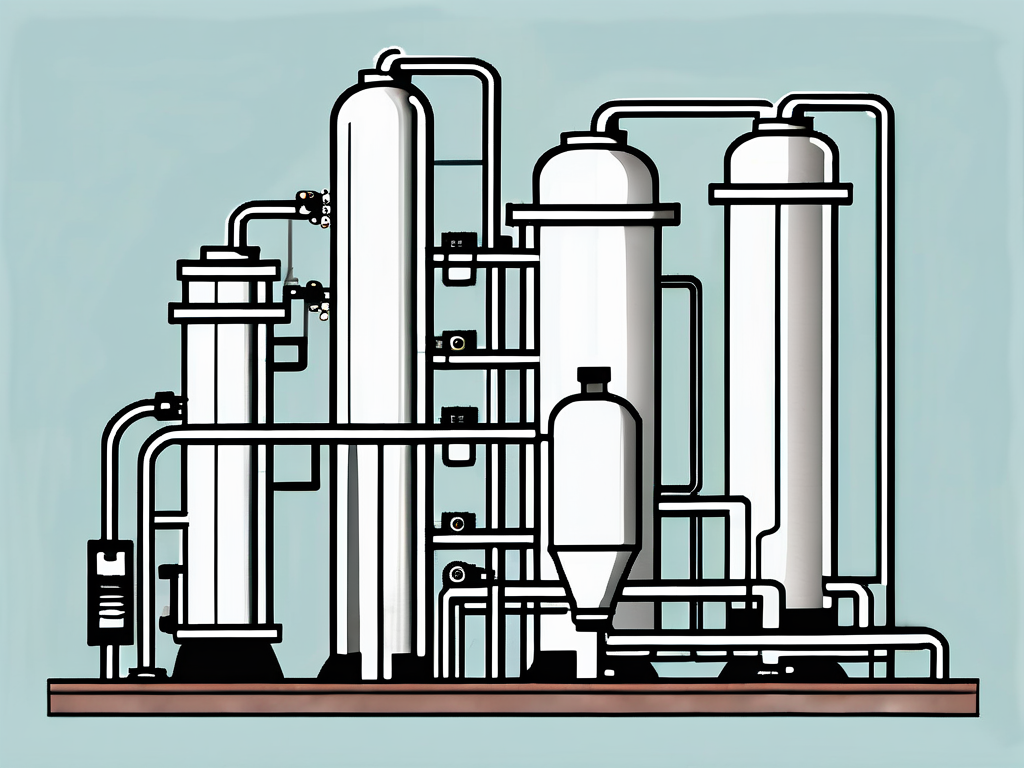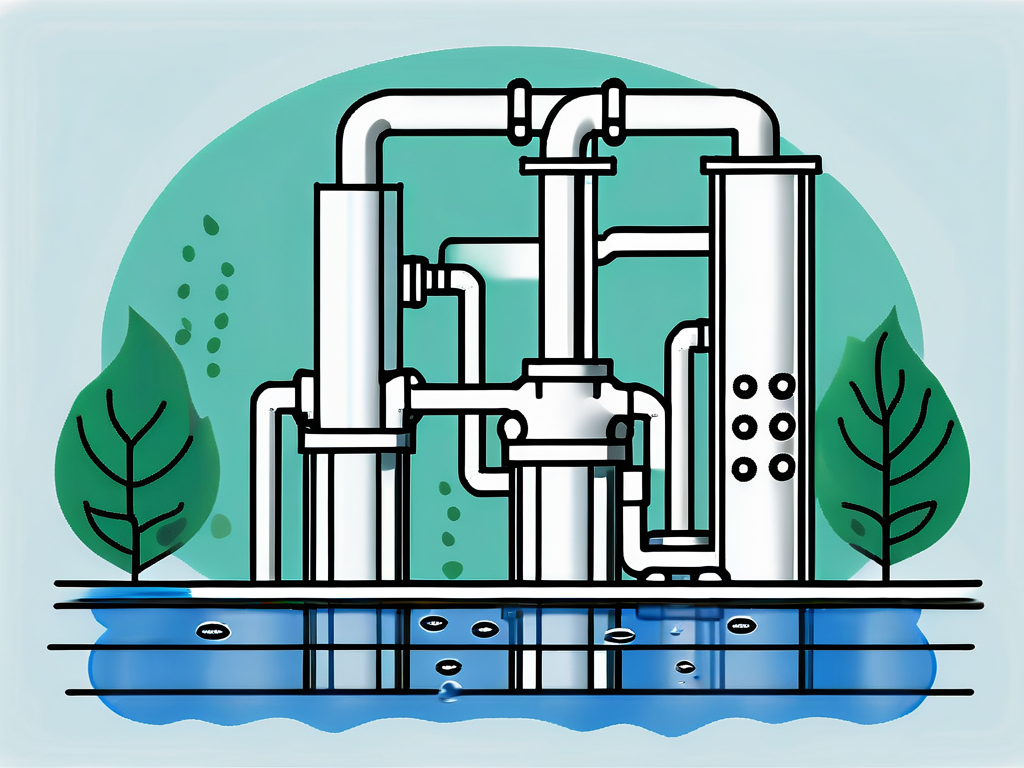
Anaerobic Membrane Bioreactor: Wastewater Treatment Explained
The Anaerobic Membrane Bioreactor (AnMBR) is a revolutionary technology in the field of wastewater treatment. It combines the process of anaerobic digestion, which is a biological process that breaks down organic matter in the absence of oxygen, with membrane filtration, a physical process that separates particles based on size. This combination results in a highly efficient and effective wastewater treatment system.
AnMBRs are increasingly being used in various industries, including food and beverage, pharmaceuticals, and municipal wastewater treatment, due to their numerous advantages over conventional wastewater treatment methods. These advantages include high organic matter removal efficiency, low sludge production, energy recovery in the form of biogas, and the potential for water reuse.
Principle of Operation
The operation of an AnMBR involves two main stages: anaerobic digestion and membrane filtration. In the anaerobic digestion stage, microorganisms break down organic matter in the wastewater into simpler compounds, mainly methane and carbon dioxide. This process occurs in the absence of oxygen and is facilitated by a consortium of bacteria, including hydrolytic, acidogenic, acetogenic, and methanogenic bacteria.
The membrane filtration stage involves the separation of the treated wastewater from the sludge. This is achieved by passing the mixture through a membrane with pore sizes smaller than the size of the bacteria and suspended solids. The treated water passes through the membrane, while the bacteria and solids are retained, resulting in a clear and high-quality effluent.
Hydraulic Retention Time
One of the key operational parameters in an AnMBR is the hydraulic retention time (HRT), which is the average time the wastewater spends in the reactor. The HRT is determined by the volume of the reactor and the flow rate of the wastewater. It is a critical parameter as it affects the efficiency of the anaerobic digestion process and the quality of the treated effluent.
A longer HRT allows for more complete digestion of the organic matter, resulting in higher methane production and lower residual organic matter in the effluent. However, it also means a larger reactor volume and higher capital and operational costs. Therefore, the optimal HRT must be determined for each specific application, taking into account the characteristics of the wastewater and the desired effluent quality.
Sludge Retention Time
Another important operational parameter is the sludge retention time (SRT), which is the average time the bacteria spend in the reactor. The SRT is controlled by the rate of sludge wastage, which is the removal of excess sludge from the reactor. A longer SRT allows for the growth of slow-growing bacteria, such as methanogens, which are essential for the anaerobic digestion process.
However, a longer SRT also means a higher concentration of bacteria in the reactor, which can lead to membrane fouling. Therefore, the optimal SRT must be determined for each specific application, taking into account the characteristics of the wastewater and the desired effluent quality.
Advantages of AnMBR
There are several advantages of using AnMBR for wastewater treatment. One of the main advantages is the high organic matter removal efficiency. AnMBRs can remove more than 95% of the organic matter in the wastewater, which is significantly higher than conventional aerobic treatment methods. This high removal efficiency results in a high-quality effluent that can potentially be reused for irrigation or industrial processes.
Another advantage of AnMBRs is the low sludge production. Since the organic matter is converted into methane and carbon dioxide, the amount of sludge produced is significantly less than in aerobic treatment methods. This reduces the cost and environmental impact of sludge disposal.
Energy Recovery
AnMBRs also offer the potential for energy recovery in the form of biogas. The methane produced during the anaerobic digestion process can be captured and used as a source of renewable energy. This can offset the energy consumption of the wastewater treatment plant and reduce its carbon footprint.
Furthermore, the heat generated during the combustion of the biogas can be used to maintain the temperature of the reactor, which is typically operated at mesophilic (30-40°C) or thermophilic (55-60°C) conditions. This further enhances the energy efficiency of the system.
Water Reuse
Another potential benefit of AnMBRs is the possibility of water reuse. The high-quality effluent produced by AnMBRs can potentially be reused for irrigation or industrial processes. This can contribute to water conservation and reduce the demand for freshwater resources.
However, the feasibility of water reuse depends on the specific requirements of the intended use and the local regulations. For example, the effluent may need to be further treated to remove residual nutrients or pathogens before it can be reused for irrigation.
Challenges and Limitations
Despite the numerous advantages, there are also several challenges and limitations associated with the use of AnMBRs for wastewater treatment. One of the main challenges is membrane fouling, which is the accumulation of bacteria and solids on the membrane surface. This can reduce the membrane permeability and increase the operational costs due to the need for frequent membrane cleaning or replacement.

Another challenge is the potential for the release of greenhouse gases, such as methane and nitrous oxide, during the anaerobic digestion process. These gases have a much higher global warming potential than carbon dioxide and their release can contribute to climate change.
Membrane Fouling
Membrane fouling is a major challenge in AnMBRs. It is caused by the accumulation of bacteria and solids on the membrane surface, which can reduce the membrane permeability and increase the operational costs. There are several strategies to mitigate membrane fouling, including the use of anti-fouling membranes, the optimization of operational parameters, and the use of physical or chemical cleaning methods.
However, these strategies can only reduce, not eliminate, membrane fouling. Therefore, research is ongoing to develop more effective strategies to prevent or mitigate membrane fouling in AnMBRs.
Greenhouse Gas Emissions
Another challenge associated with AnMBRs is the potential for the release of greenhouse gases during the anaerobic digestion process. Methane, which is a major product of anaerobic digestion, has a global warming potential 25 times higher than carbon dioxide. Therefore, it is crucial to capture and utilize the methane produced during the anaerobic digestion process to minimize its release into the atmosphere.
Another potential source of greenhouse gas emissions is nitrous oxide, which can be produced during the denitrification process. Nitrous oxide has a global warming potential 298 times higher than carbon dioxide. Therefore, it is important to optimize the operational parameters to minimize the production of nitrous oxide.
Future Perspectives
The use of AnMBRs for wastewater treatment is a rapidly growing field, with significant potential for further development and innovation. One of the main areas of research is the development of more effective strategies to prevent or mitigate membrane fouling. This includes the development of new membrane materials with anti-fouling properties, the optimization of operational parameters, and the use of advanced cleaning methods.
Another area of research is the enhancement of biogas production and utilization. This includes the optimization of the anaerobic digestion process to maximize methane production, the development of more efficient biogas capture and utilization systems, and the exploration of new uses for biogas, such as the production of biofuels or chemicals.
Membrane Development
One of the main areas of research in AnMBRs is the development of new membrane materials with anti-fouling properties. This includes the use of nanomaterials, such as carbon nanotubes or graphene oxide, which have shown promising results in reducing membrane fouling. Another approach is the modification of the membrane surface to make it more hydrophilic, which can reduce the adhesion of bacteria and solids.
However, the development of new membrane materials is a complex process that requires a thorough understanding of the fouling mechanisms and the interactions between the membrane and the wastewater. Therefore, further research is needed to develop more effective and affordable anti-fouling membranes for AnMBRs.
Biogas Enhancement
Another area of research is the enhancement of biogas production and utilization. This includes the optimization of the anaerobic digestion process to maximize methane production. For example, the use of pre-treatment methods, such as thermal, chemical, or mechanical pre-treatment, can enhance the accessibility of the organic matter and increase the methane yield.
Furthermore, the development of more efficient biogas capture and utilization systems can enhance the energy recovery from AnMBRs. This includes the use of advanced gas storage and delivery systems, and the exploration of new uses for biogas, such as the production of biofuels or chemicals.
Conclusion
In conclusion, AnMBRs are a promising technology for wastewater treatment, offering numerous advantages over conventional methods, including high organic matter removal efficiency, low sludge production, energy recovery, and the potential for water reuse. However, there are also several challenges and limitations, such as membrane fouling and the potential for greenhouse gas emissions, which need to be addressed to further enhance the performance and sustainability of AnMBRs.

Future research should focus on the development of more effective strategies to prevent or mitigate membrane fouling, the enhancement of biogas production and utilization, and the exploration of new applications for AnMBRs. With continued research and innovation, AnMBRs have the potential to revolutionize the field of wastewater treatment and contribute to a more sustainable and resilient water sector.



